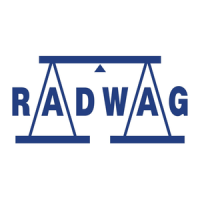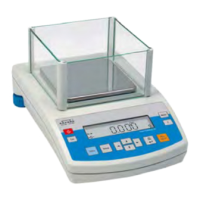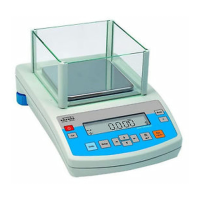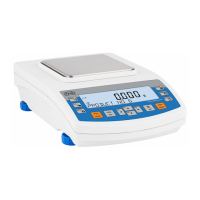Do you have a question about the RADWAG PS 3500.R2 and is the answer not in the manual?
Details the various connection ports available on the balance for peripheral devices.
Describes the PS R2.H series balances and their features, including IP rating.
Explains the proper application of the balance for determining load values in a laboratory.
Lists incorrect usage scenarios to avoid, such as dynamic weighing or using in explosive areas.
Specifies ideal locations and conditions for balance setup, avoiding vibrations and dust.
Step-by-step guide for carefully removing the balance from its packaging and assembling components.
Details on connecting the balance to the power supply using the correct adapter and initial power-on sequence.
Essential procedures for proper and reliable weighing, including steady loading and central placement.
Step-by-step guide on how to perform the zeroing function on the balance.
Explains how to use the taring function to determine the net weight of an object.
Configuration options for parameters within the weighing mode.
Process for automatically or manually adjusting the balance's internal calibration.
Procedures for performing manual internal and external balance calibration.
Management of user accounts, including name, password, access level, and language settings.
Automatic saving of measurement data, including date, result, user, and working mode.
Functionality for counting small objects of identical mass.
Mode for verifying if sample mass falls within defined low and high thresholds.
Procedure for determining the density of solid substances using a kit.
Configuration of RS232 serial ports, including baud rate and parity settings.
Setup and connection procedures for the balance's Wi-Fi interface.
Selecting the correct port (COM, USB, WIFI) for computer connectivity.
Configuring the balance to send data to a connected printer, including port and printout settings.
A comprehensive list of commands for controlling the balance via RS232 interface.
Detailed descriptions of specific commands like Zero balance, Tare balance, etc.
Information about the kit for determining the density of solids and liquids.
Details the various connection ports available on the balance for peripheral devices.
Describes the PS R2.H series balances and their features, including IP rating.
Explains the proper application of the balance for determining load values in a laboratory.
Lists incorrect usage scenarios to avoid, such as dynamic weighing or using in explosive areas.
Specifies ideal locations and conditions for balance setup, avoiding vibrations and dust.
Step-by-step guide for carefully removing the balance from its packaging and assembling components.
Details on connecting the balance to the power supply using the correct adapter and initial power-on sequence.
Essential procedures for proper and reliable weighing, including steady loading and central placement.
Step-by-step guide on how to perform the zeroing function on the balance.
Explains how to use the taring function to determine the net weight of an object.
Configuration options for parameters within the weighing mode.
Process for automatically or manually adjusting the balance's internal calibration.
Procedures for performing manual internal and external balance calibration.
Management of user accounts, including name, password, access level, and language settings.
Automatic saving of measurement data, including date, result, user, and working mode.
Functionality for counting small objects of identical mass.
Mode for verifying if sample mass falls within defined low and high thresholds.
Procedure for determining the density of solid substances using a kit.
Configuration of RS232 serial ports, including baud rate and parity settings.
Setup and connection procedures for the balance's Wi-Fi interface.
Selecting the correct port (COM, USB, WIFI) for computer connectivity.
Configuring the balance to send data to a connected printer, including port and printout settings.
A comprehensive list of commands for controlling the balance via RS232 interface.
Detailed descriptions of specific commands like Zero balance, Tare balance, etc.
Information about the kit for determining the density of solids and liquids.
| Maximum Capacity | 3500 g |
|---|---|
| Readability | 0.01 g |
| Display | LCD |
| Linearity | ±0.02 g |
| Stabilization Time | 2 s |
| Protection Class | IP 43 |
| Operating Temperature | 10 to 40 °C |
| Calibration | External |
| Interface | RS232 |
| Power Supply | 100 - 240 V AC 50/60 Hz |
| Repeatability | 0.01 g |











